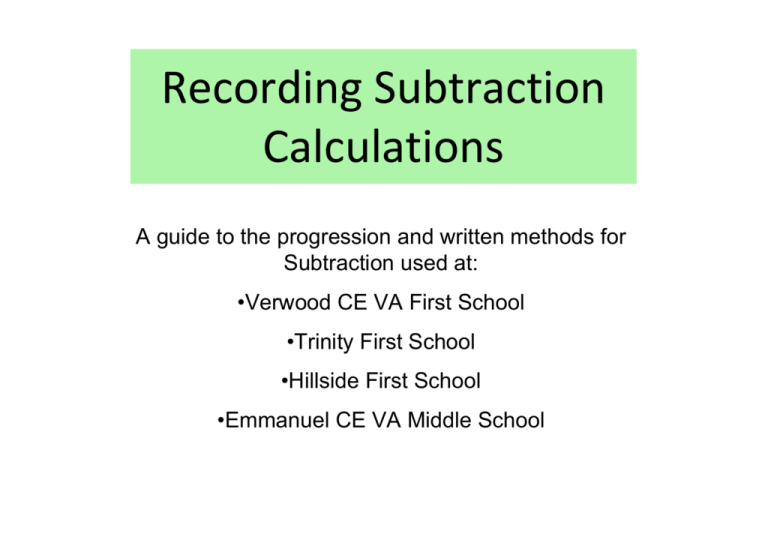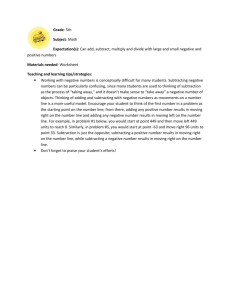Subtraction Methods for Verwood Schools
advertisement

Recording Subtraction Calculations A guide to the progression and written methods for Subtraction used at: •Verwood CE VA First School •Trinity First School •Hillside First School •Emmanuel CE VA Middle School The following is designed to help pupils and parents understand the written methods for subtraction used in all of the First Schools and onward through the Middle School in Verwood at Key Stage 1 and Key Stage 2 (from reception to year 6). It is important to realise that the methods shown in this document might not be what parents were taught while they were at school, but they are common methods used today in the teaching of Mathematics. This presentation starts off with the methods taught in reception and year 1 and progresses through to the subtraction methods and some examples of subtraction problems that your child can expect to come across in years 5 and 6. Here’s some Key vocabulary that can be used when talking about subtraction with your child less count back subtract ‐ minus take away difference Subtraction • Children begin with singing songs about subtraction and developing their understanding of what subtraction means. – Five Little Men in a Flying Saucer – Five Current Buns – Ten Fat sausages • Take away is supported with visual objects to help the children calculate 1 less and 10 less in a set of objects. • Subtraction is also developed through children learning to count back and using a number line or number square to support this. • In the early years your child will have lots of practical experiences involving numbers including practicing forming their numbers, ordering numbers up to 10 and then 20, finding the missing numbers and identifying one‐digit and small two‐digit numbers. This will then lead onto adding and subtracting small numbers. • When your child is first learning the concept of subtraction they will use a visual number track which they can use in many practical ways. They may 'jump' or 'walk' along a large number track on the floor or use their finger to move along a smaller laminated number track. If they were trying to solve 6 ‐ 3. They would start at the large number at the beginning of the number sentence and physically move down the number track three spaces and record where they have landed. A very basic way for pupils to subtract using a written method from an early age is to use a number track. The number track itself would be given to the pupil on a pre‐ prepared sheet with the numbers already on it. The pupil would have to annotate the sheet with the arrows. e.g calculate 9 ‐ 4 = ? -1 -1 -1 -1 0 1 2 3 4 5 6 7 8 9 When subtracting using a number track the pupil has to identify and circle the start number and subtract to the left. Starting at 9 count 4 places to the left. ANSWER = 5 Following on from this we would begin to use a Number line. The most basic number line involves subtracting numbers one at a time onto a FULLY LABELLED line e.g calculate 12 ‐ 5 = ? -1 -1 -1 -1 -1 0 1 2 3 4 5 6 7 8 9 10 11 12 When subtracting using a number line you ALWAYS start from the far right hand side of the line and subtract to the left. Starting at 12 count 5 places to the left. ANSWER = 7 Once your child has grasped this concept the next step is to use a blank number line • Using a blank number line. Starting from the number on the right hand side and subtracting in ones in your head you can calculate things like 21 ‐ 7 = ? 14 21 From this we can see that the answer = 14 Once your child has grasped this concept the next step is to subtract using bridging on a number line • Using a blank number line. Starting from the number on the right hand side you subtract down to the nearest multiple of 10, then subtract the remaining amount. -5 e.g 25 ‐ 8 = ? -3 17 20 25 From this we can see that the answer = 17 A useful strategy when subtracting numbers which are close to a multiple of 10 using a number line can be to ‘over compensate’ • Using a drawn number line, starting from the largest number your child needs to partition to count back in 10’s in their head – however they will subtract too much and need to compensate by adding at the end e.g 77 ‐ 29 = ? - 10 - 10 - 10 +1 47 48 57 67 Answer = 48 77 Once your child has grasped a blank number line and bridging for subtracting single digit numbers they can then begin the following: • Using a drawn number line to subtract 2‐digit numbers, starting from the number on the right hand side your child needs to partition to count backwards to the left in 10’s and 1’s in their head – recording this as they go along e.g 34 ‐ 22 = ? - 10 -1 12 - 10 -1 13 14 24 34 Answer = 12 The next step in using a number line when subtracting is to partition the numbers according to their place value Using this method your child needs to have a good grasp of place value (this is the value of the digits within a number). e.g 123 ‐ 47 = - 40 -7 76 83 123 Answer = 76 This can lead to the subtraction of bigger whole numbers where, again, a knowledge of place value is essential e.g 1473 ‐ 387= - 300 -80 -7 1086 1093 1173 Answer = 1086 1473 For most pupils the number line method will be what they will need up until their Key Stage 2 SATs and in quite a few cases for the remainder of their time at school. This is simply because it is the most reliable method and reinforces a pupil’s grasp of place value. However, once pupils have demonstrated a good grasp of place value and an understanding of the value of number then they can progress onto the quicker method of column subtraction. Before pupils use Column Subtraction they can use ‘expanded step subtraction’ This requires pupils to take away from a number one step at a time according to the place value of the digits within the number being subtracted e.g 324 – 136 324 ‐ 136 324 – 100 = 224 224 – 30 = 194 194 – 6 = 188 Answer = 188 The first step in learning column subtraction is to use Expanded column subtraction. The numbers are written fully in columns according to their full place value. e.g calculate 264 ‐ 131 3. Finally we subtract the 100 from the 200. 200 – 100 = 100 200 60 4 ‐ 100 30 1 100 30 3 = 133 1. We ALWAYS start with the column furthest to the RIGHT hand side and subtract the 1 from the 4. 2. Next step is to subtract the 30 from the 60 in the next column to the left. 60 – 30 = 30 4–1=3 Answer = 133 Column subtraction is similar to column addition in the way in which it is set out. The numbers MUST be lined up in columns according to their place value. e.g calculate 874 ‐ 342 3. Finally we subtract the 3 from the 8. 8–3=5 H T U 8 7 4 ‐ 3 4 2 5 3 2 1. We ALWAYS start with the column furthest to the RIGHT hand side and subtract the 2 from the 4. 2. Next step is to subtract the 4 from the 7 in the next column to the left. 7–4=3 4–2=2 Answer = 532 At times when using column subtraction the value you are subtracting is bigger than the value you are subtracting from. When this happens you need to ‘take’ from the value to the left. e.g calculate 735 ‐ 467 3. Finally we subtract the 4 from the 6 6–4=2 H T U 6 7 ¹²3 ¹5 ‐ 4 6 7 2 6 8 1. As 7 is bigger than 5 we ‘take’ from the 3 to turn the 5 into a 15. We then calculate 15 – 7 = 8 2. This leaves us with 2 in the tens column but again we need to take from the column to the left of this to turn the 2 into a 12. We can then calculate 12 – 6 = 6 Answer = 268 At times when you have to borrow from the column to the left there is nothing to borrow and you have to borrow from further to the left e.g calculate 1000 ‐ 467 1. As 7 is bigger than 0 we ‘take’ from the left however the ONLY digit we can borrow from is in Th H T U 3. Finally we the thousands column so 9 0 9 subtract the we need to borrow this 1 ¹0 ¹0 ¹0 4 from the 9 BUT you can only bring it ‐ 4 6 7 in the across one column at a Hundreds time which leaves ‘9’ in 5 3 3 column each column as you bring it across. We can 9–4=5 now calculate 2. This leaves us with 9 in the tens column so we 10 – 7 = 3 take the 6 away from the 9 We can then calculate 9 - 6 = 3 Answer = 533 Once a pupil has grasped how to accurately subtract they will then need to be able to apply this to word problems. e.g If Tom has a piece of wood which is 1.5m long and he cuts off 55cm, how much does he have left? This problem involves calculating 1.5m – 55cm As the units of measure are different we need to convert one of them BEFORE subtracting. As there are 100cm in a metre we can change 1.5m to 150cm This gives us 150cm – 100cm 4 1 ¹ 5 ¹0 ‐ 5 5 9 5 Answer = 95cm The following 4 slides show examples of the types of questions that the pupils will get involving subtraction in year 6 when they do their SAT tests. 1. Kate has a piece of ribbon one metre long. She cuts off 30 centimetres. How many centimetres of ribbon are left? cm 1 mark 2. Here are three bags in a shop A B C £11.50 £14.65 £ 16.50 How much does bag B cost to the nearest pound? £ 1 mark Jamie buys bag A and bag C. How much change does he get from £40? Show your working. You may get a mark. £ 2 marks 3. A rectangular swimming pool is 25 metres long and 10 metres wide. David swims 5 lengths. Rosie swims 12 widths. How much further does David swim than Rosie? length 25m width 10m Show your working. You may get a mark. metres 2 marks 4. Calculate 2006 – 289 1 mark 5. Calculate 15.05 – 14.84 1 mark With most subtraction questions you can CHECK your work by doing the inverse calculation (the opposite). In mathematics the inverse of subtraction is ADDITION e.g it is true that 15 – 9 = 6 Knowing this we can also see that 9 + 6 = 15 The addition should use the same numbers as the subtraction but in a different order. For guidance on the methods of ADDITION used in the four Verwood schools please see the addition methods PowerPoint or PDF file.



